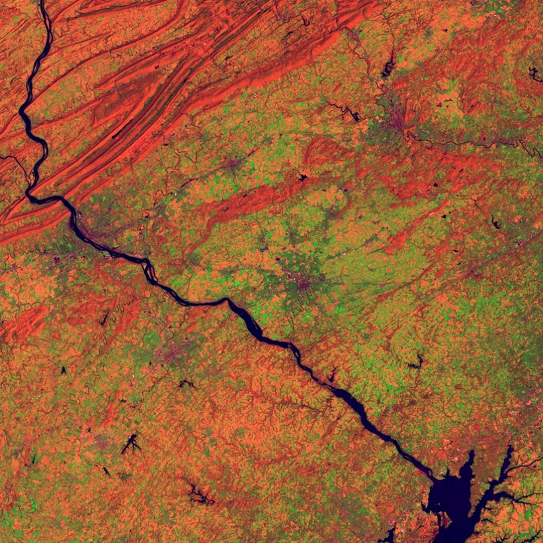[Animating]
Introduction: Animating Worlds
Adam Nocek and Stacey Moran
The world is as lively and full of vitality as it has ever been. This may seem like a strange claim given that we are writing this in the middle of a pandemic, and by all accounts, the world has been at a standstill for close to a year now. At the time of writing this introduction, 2.96 million people are dead, and over 563,000 of them are in the United States alone. Travel is extremely limited; the global economy is, yet again, in crisis; universities are hemorrhaging because students aren’t returning to campus; and the boredom and fatigue of isolation has put to bed any good intentions wrapped in up “taking a break” from it all. Countless city centers, campuses, businesses, cultural institutes, and entertainment facilities are ghost towns.

And yet, this view of the quarantine “lock down” and its resultant economic “shut down,” which is starting to sound like a refrain, is troubling on a number of levels: it masks how the world continues to be an incredibly animated place. The biosphere cares little for the temporary “pause” placed on the activities of global consumerism—or rather, it doesn’t care in the way humans do. For example, rewilding no longer seems like the hopeless dream of environmentalists, but it is a real agent of transformation that, if allowed to continue, could foster a recovery of biodiversity. Similarly, biochemical, geophysical, and atmospheric activity are not on pause: climate change remains a force that continues to devastate life on earth. Hurricanes, wildfires, drought—these all continue to rage on. But, to even suggest that the human world has slowed down does political violence: it conceals the logics of race and class that make it impossible for essential workers to stop working and to seek the isolation that the privileged cannot stop taking for granted (Agamben 2020). Their worlds are animated—they’re moving, shifting, and incredibly uncertain. Healthcare workers and other “frontline” workers, as well as homeless shelters, hospitals, and unemployment offices, are buzzing with a level of activity they’re not equipped to handle. The metaphor of slowing also conceals the fact that digital technologies are animating so many aspects of human life right now: from work, school, shopping, socializing, and meal services to healthcare, biomedical research, and now vaccine distribution and the global economy (the wealth of internet companies has doubled)¹.

This inaugural issue of Techniques Journal on “Animating” is not about the COVID-19 pandemic. Nor is it directly about the anthropocentric and Anglo/Eurocentric framing of this crisis. Many of the pieces included in this collection were solicited from talks given at Arizona State University’s Center for Philosophical Technologies in 2019, well before the coronavirus transformed life on the planet. Despite this, the pandemic is a part of the fabric of daily life now and is very likely to change it for good. These examples serve heuristic purposes: whether it’s the computational technologies redesigning the architectures of social life or the replicating and mutating of SARS-CoV-2 at a rate that seemed unimaginable only six months ago, human and nonhuman worlds seem to be animated in new ways, even if this is cause for tremendous pain and suffering. These current examples serve to draw attention to how our worlds are animated, whether we notice them or not.
Still, in the modern West, the claim that our worlds are animated seems less like a serious philosophical proposition than it does a useful metaphor for reframing how we engage with human and nonhuman worlds. Many of us tend not to think about our worlds as actually animated, which is to say, filled with life, vitality, or even endowed with “soul” and in possession of a degree of autonomy irreducible to its surroundings. If the latter is an approximation of what it means to be “animate,”² then biological systems, to say nothing of physical systems, artifacts, and digital technologies, are not, strictly speaking, animated; we regard them as materially determined systems that can be observed, described, and understood in terms of a system of causes.
For example: From where does SARS-CoV-2 derive its liveliness? From a bioscientific perspective, liveliness is derived from its molecular makeup. This was initially determined by sequencing its nucleic acid, which opened the door to omics-scale research on the virus and then therapeutic interventions (see Ray and Srivastava 2020). In a slightly different register, we might ask: What’s animating the unprecedented transmission of the virus across the globe? There is no simple answer to this question either, but it involves, at the very least, a range of complexly related phenomena, operating at multiple scales at once, and intersecting perspectives such as global finance, political sovereignty, conspiracy theories circulated on social media, the priorities of the Trump administration, science-deniers and anti-maskers, and the unequal distribution of healthcare and resources, in conjunction with the diverse biosocial systems of the human species. Despite this incredible complexity, scientists are hard at work hunting down not just the causal mechanisms responsible for animating the virus—its origin and zoonotic jump, as well as its spread and mutations—but also the forces capable of sapping its vitality through therapeutic interventions and the vaccination of the human species.
Here’s the takeaway: in the modern West, the “animation of matter” is considered a metaphor. Sure, it “appears” that algorithms have a life of their own or that dangerous fictions animate political theatre in the US; nevertheless, we firmly believe there are material, if nonlinear, explanations for these phenomena that can be mapped and understood. Similarly, there is no mysterious vital principle underlying living processes; such biological spiritualism was rooted out long ago and doesn’t hold a candle to the explanatory power of data science in the postgenomics era. Even Jane Bennett’s (2009) “vibrant matter,” which has ushered in a wide appreciation for “nonorganic life” across the arts and humanities, disassociates itself from all hints of the “old vitalism” for fear of being connected to immaterial and spiritual explanations—or in short, to anything that is exterior to material causes. This disavowal of soul talk, religion, and spirituality is, on the one hand, the very condition for our modernity. Such renunciations, as Gaymon Bennett makes abundantly clear in this issue, are the sine qua non of modern secularism, which includes the new materialisms that make ample use of “magic” and the “occult” (Morton 2013) but remain just this side of the line that divides scientific modernity from its Others.

On the other hand, however, it is just this line in the sand—which materialist philosophy (whether old or new), so obsessed with the rigors of scientific rationality, cannot imagine crossing—that divides modernity from animate thinking, making, and living. Still, by “animate” we do not have in mind the assertion of a metaphysical system (aligned with panpsychism and/or panexperientialism) where rocks and trees literally have immaterial souls that are different in kind from the material world. This is a metaphysical system still in the business of hunting down causes and explanations and deciding on what objectively exists. This puts us in the same old vise grips: there is “reality” and then there is “illusion.” No, this issue of Techniques Journal is more closely aligned to how Isabelle Stengers, citing the anthropologist Philippe Descola, frames animist thought in her provocative piece, “Reclaiming Animism”: namely, that “animists have no word for ‘really,’ for insisting that they are right and others are victims of illusions” (2012, 4). As she explains it, the seductive powers of modernity have led us to feel authorized to speak about animism, and certain philosophical concepts claiming to know something about animism have been used to justify both colonialism and the divide it created between “reality” and “illusion.” And as we write this introduction, we are quick to acknowledge that our own training and situatedness places us on the colonizing side of the divide.
What Stengers is getting at here, which captures the spirit of certain animist philosophies, especially Indigenous animisms (e.g., the Lakota, Ojibwe, Maori, Yanomami), is the conceptual and practical resistance to laying claim to what is and is not the case. The question of what there “really” is makes no sense within these animist cosmologies. As Irving Hallowell (1960), Nurit Bird-David (1999), Philippe Descola (2013), Eduardo Viveiros de Castro (2014), David Abram (1996), Val Plumwood (1993), Graham Harvey (2006), Eduardo Kohn (2013), and a host of others have elaborated over the last several decades, animist cosmologies, which affirm some version of the Ojibwe respect for “other-than-human persons,” raise a host of ontological puzzles. However, according to Harvey, traversing these diverse animisms is a felt relation to the world in which each being is regarded, on the one hand, as a relational, connected, and communicating being, and on the other hand, as possessing a unique and irreducible “perspective” on the relations it shares (2006, 179–203). According to Plumwood, all systematizing discourses, including pantheistic ones, are “thefts” that rob the world of its autonomy: “A view of the whole,” she writes, as spiritually and ecologically significant is in no way a substitute for a recognition of the great plurality of particular beings in nature as capable of their own autonomy, agency and ecological or spiritual meaning. For this, only a richer account of individuals themselves, as well as recognition of their intricate interconnectedness, will do. (1993, 128)

Animist epistemologies are not only relational but are also situated and particular. The relations a being—whether human, animal, technological, or elemental—shares with another are its own: they cannot be reduced to, explained by means of, or predicted from another set of relations. Every act of human and nonhuman relating is singular and autonomous, which means there is no way of making this act fully available to another being. Thus, human ways of relating, or being “persons,” do not exhaust the possibilities of relating, since there is a plurality of other ways (of being persons), and these other ways are equally unavailable for objectification. In other words, there is no perspective (scientific, religious, metaphysical, etc.) authorized to claim what is or is not the case, or what is or is not meaningful relation. As Stengers might put it, animism refuses to prescribe how beings are gathered by a situation, what this gathering means, and what it may eventually be capable of becoming.
The conceptual resonances between animist cosmologies and Western theoretical systems go far beyond Stengers, of course, and are attached to a wide range of intellectual projects. And to be sure, we are writing this introduction as the unfortunate inheritors of the violence perpetrated by Western metaphysics. However, we are especially sensitive to thought and practice stemming from what Boaventura de Sousa Santos (2009) calls the “non-occidental West,” or what Arturo Escobar (2018) calls the “alternative Wests,” and seek connections running between Indigenous animisms and ecofeminism, for example, which are explored in the works of Val Plumwood (1993), Laura Donaldson (2003), and Deborah Bird Rose (1992, 2013). Likewise, Viveiros de Castro (2014) exploits the relation between Amerindian perspectivism and Gilles Deleuze and Félix Guattari’s philosophy of immanence, and this has been foundational for debates in comparative metaphysics. Eco-deconstruction, and in particular, Jacques Derrida’s difficult assertion that “there is no world, there are only islands” (2011, 9), explored at length by Cary Wolfe (2020, 64), might also be considered a close cousin of the animist perspectives discussed here. And one of our preferred ways to think alongside animist cosmologies comes to us from Alfred North Whitehead, who insists that all occasions of experience (from God to a dust particle) are at once present in every other experience (relationism) and are also radically isolated—unique drops of subjective feeling incapable of being shared with or objectified by others (1978, 45, 239, 244, 277).
The point here is not to assert that these alternative Western theoretical frames endorse the same thing, nor that they all endorse animist cosmologies per se. What they do share is a commitment to epistemic humility: to intervening in the seduction of causal explanation and refusing to buy into the modern colonial project that proclaims a perspective (human, informatic, mathematical, or otherwise) can answer on behalf of any other one. What gathers these diverse projects, then, is a commitment to ramifying the perspectives, speculations, and cosmologies that resist being captured in a framework that transcends them—e.g., in the discourse of “Nature,” “Information,” and so on. To the extent that these and other works fabricate concepts, propositions, and ways of living that interfere with the architectures of material causation that haunt Western modernity and create spaces for multiplying what escapes capture in a transcendental scheme, then they have succeeded in devising techniques for animating worlds.
This brings us to the pieces assembled in this issue of Techniques Journal. Each of the pieces, whether academic, para-academic, or artistic, draws on a range of disciplinary frames to imagine techniques for animating a slice of the cosmos. Despite this, the works do not sit comfortably in a collection on “animism” (as a spiritual and metaphysical practice) or “animation” (as a technical practice) narrowly construed, although both are referenced and conceptualized throughout. Rather, and much more provocatively, the works might be thought of as hanging together through their shared concern for disrupting what our well-worn habits of modern thought and practice have homogenized, reduced, and otherwise explained in the service of accommodating overarching frameworks. Following what Thomas LaMarre (2009) provocatively asserts in his book The Anime Machine: A Media Theory of Animation, “animatism” has less to do with the seamless movement between heterogeneities (closed compositing) and more to do with the interval between them (open compositing). By not collapsing scales of time and space, we keep indeterminacy alive and bring what animates the relation between heterogeneities to the fore.
Similarly, these works, each in their own way, attempt to open up intervals and interstitial spaces in various domains. Whether it’s in the biological sciences (Bennett, Espelie), psychoanalysis and food performance (Loo), the administrative arts (Kuzmanovic and Gaffney), experimental documentary (Espelie), the embodied experiences of information processing (LaMarre), or the urban environment (Tromarama), when taken together these works give voice to a range of techniques and well-honed practices for pluralizing the gaps and fissures that make it impossible to hunt down causal mechanisms. It is in this sense that we might say that the pieces craft techniques—some genealogical and conceptional, others pragmatic, spiritual, or performative—for introducing anima into modernity, only if we acknowledge the power of such naming practices and not let them discount the existence of radically divergent worlds of meaning and experience.
Our hope is that the techniques proposed here, in conversation with our guest respondents, will catalyze the production and dissemination of techniques for animating worlds. If the pandemic has taught us anything, then it is that human and nonhuman perspectives on the pandemic are radically divergent, and they cannot be modeled, explained, or reduced to a chain of causes, no matter how complex. We need ways of imagining and practicing human and nonhuman relation without resorting to tired slogans like “We’re all in this together.” The pandemic, operating in conjunction with the economic and racial crises, has clearly demonstrated that there is no “shared world.” There is a multiplicity of worlds, and this needs to be affirmed instead of silenced and negated. There are worlds of white privilege, and then there are worlds inhabited by Black bodies negated by systemic racism; there are worlds of technological optimism and profiting, and then there are worlds of digital exploitation and extraction; and there are also worlds of anthropocentrism, and then there are those nonhuman worlds that suffer at the hands of human exceptionalism. It is our wish that the techniques for animating worlds proposed here might also be imagined as techniques for resisting the reduction of many worlds to one world.
In order to generate new possibilities for thought and action and ultimately keep the question of animating worlds open to debate, we have invited two guest respondents: Deborah Levitt and Phillip Thurtle. Both accomplished theorists of animation in their own right, their role as synthesizers, instigators, and provocateurs is invaluable to this issue: not only do we see them as weaving together extant lines of inquiry and opening up new frames of analysis on animating, but we also see them as transforming the work curated here into material for public engagement. As mediators between the contents of the journal and the public, the respondents make possible a living conversation about what it means to design and construct techniques for animating worlds today and in the future.
¹ https://fortune.com/2020/07/01/best-stocks-to-buy-2020-coronavirus-markets-economy/
² In the modern West, the German physician and chemist Georg Stahl hypothesized that living matter, as opposed to dead matter, possessed a vital substance or “living stuff” known as anima (see Stahl 1708; Harvey 2006, 2–3). Famously, the nineteenth-century anthropologist EB Tylor used Stahl’s conception of “animism” to categorize “primitive” humans and argued, moreover, that “animism was not only the earliest religion but remained definitive of religion. Religion,” according to Graham Harvey’s reading of Tylor, “is an animist mistake about the nature of the world in which people ‘believe in souls or spirits’ or discourse about non-empirical beings” (Harvey 2006, 6). This history of concept and practice of animism, and how it has come to be associated with nonmodern, occult, and religious practices, is examined in Harvey’s work, Animism: Respecting the Living World.
References
- Abram, David. 1996. The Spell of the Sensuous: Perception and Language in a More-than-Human World. New York: Vintage.
- Agamben, Giorgio. 2020. “The Invention of an Epidemic.” In European Journal of Psychoanalysis. Originally published on Quodlibet. https://www.quodlibet.it/giorgio-agamben-l-invenzione-di-un-epidemia.
- Bennett, Jane. 2009. Vibrant Matter: A Political Ecology of Things. Durham: Duke University Press.
- Bird-David, Nurit. 1999. “‘Animism’ Revisited: Personhood, Environment, and Relational Epistemology.” Current Anthropology 40: S67-S91.
- Derrida, Jacques. 2011. The Beast and the Sovereign, Volume II. Translated by Jeffrey Bennington. Chicago: University of Chicago Press.
- Descola, Philippe. 2013. Beyond Nature and Culture. Translated by Janet Lloyd. Chicago: University of Chicago Press.
- Donaldson, Laura. 2003. “Covenanting Nature: Aquacide and the Transformation of Knowledge.” Ecotheology 8, no. 1.
- Escobar, Arturo. 2018. Designs for the Pluriverse: Radical Interdependence, Autonomy, and the Making of Worlds. Durham: Duke University Press.
- Hallowell, Irving A. 1960. “Ojibwa Ontology, Behavior, and World View,” in Culture in History: Essays in Honor of Paul Radin, edited by Stanley Diamond. New York: Columbia University Press.
- Harvey, Graham. 2006. Animism: Respecting the Living World. New York: Columbia University Press.
- Kohn, Eduardo. 2013. How Forests Think: Toward an Anthropology Beyond the Human. Berkeley and Los Angeles: University of California Press.
- LaMarre, Thomas. 2009. The Anime Machine: A Media Theory of Animation. Minneapolis: University of Minnesota Press.
- Morton, Timothy. 2013. Realist Magic: Objects, Ontology, Causality. Michigan: Open Humanities Press.
- Plumwood, Val. 1993. Feminism and the Mastery of Nature. London: Routledge.
- Ray, Sandipan and Sanjeeva Srivastava. 2020. “COVID-19 Pandemic: Hopes from Proteomics and Multiomics Research.” OMICS: A Journal of Integrative Biology 24 (8): 457-459.
- Rose, Deborah Bird. 1992. Dingo Makes Us Human: Life and Land in an Australian Aboriginal Culture. Cambridge, UK: Cambridge University Press.
- –––. 2013. “Val Plumwood’s Philosophical Animism: Attentive Interactions in the Sentient World.” Environmental Humanities 3: 93-109.
- Santos, Boaventura de Sousa. 2009. “A Non-Occidentalist West?: Learned Ignorance and Ecology of Knowledge.” Theory, Culture & Society 27 (7–8): 103-25.
- Stahl, Georg E. 1708. Theoria medica vera. Halle: Literis Orphanotrophei.
- Stengers, Isabelle. 2012. “Reclaiming Animism.” e-flux, no.36.
- Viveiros de Castro, Eduardo. 2014. Cannibal Metaphysics. Translated by Peter Skafish. Minneapolis: Univocal Publishing.
- Whitehead, Alfred North. 1978. Process and Reality: An Essay in Cosmology. Corrected Edition. 1927–28. Edited by D. R. Griffin and D. W. Sherburne. New York: Free Press.
- Wolfe, Cary. 2020. Ecological Poetics; Or, Wallace Stevens’s Birds. Chicago: University of Chicago Press.
Issues articles [7]
-
Animation and Information
-
Careful Whispers, or Animated Cuts of Eating Matter and Techniques for Dark Thinking
-
Anima, Animism, Animate: Ethnography after Authenticity
-
The Digital Blues: Animating Ecocide
-
A Conversation with Tromarama
-
Dark Arts, Grey Areas, and Other Contingencies (CPT.R7)
-
Why Qs Are Worth Ten: Digressions on Language, Moving-Image Mediums, and Technicity
Guest Respondents
-

Deborah Levitt
(she/her/hers)Deborah Levitt is Assistant Professor of Culture and Media Studies at The New School. She is the author of The Animatic Apparatus: Animation, Vitality, and the Futures of the Image (Zero Books, 2018) and co-editor of Acting and Performance in Moving Image Culture: Bodies, Screens, and Renderings (Transcript Verlag, 2012). She is currently completing a book, Rendering Worlds, that investigates media’s emergent perceptual infrastructures as platforms for developing a new pluralist political imaginary. She is also co-editing, with Heather Warren-Crow, a volume of essays on animation theory (under contract with Bloomsbury).
-

Phillip Thurtle
(he/him/his or they/them/their)Phillip Thurtle is Professor of History and Chair of the Comparative History of Ideas Department at the University of Washington. He is the author and co-editor of numerous books and electronic media, including his most recent book, Biology in the Grid: Graphic Design and the Envisioning of Life (University of Minnesota Press, 2018). His research focuses on the affective-phenomenological domains of media, the role of information processing technologies in biomedical research, and theories of novelty in the life sciences. His most recent work is on the cellular spaces of transformation in evolutionary and developmental biology research and the cultural spaces of transmutation in popular culture and the arts.
Guest Respondents
-

Deborah Levitt
(she/her/hers)(she/her/hers)Deborah Levitt is Assistant Professor of Culture and Media Studies at The New School. She is the author of The Animatic Apparatus: Animation, Vitality, and the Futures of the Image (Zero Books, 2018) and co-editor of Acting and Performance in Moving Image Culture: Bodies, Screens, and Renderings (Transcript Verlag, 2012). She is currently completing a book, Rendering Worlds, that investigates media’s emergent perceptual infrastructures as platforms for developing a new pluralist political imaginary. She is also co-editing, with Heather Warren-Crow, a volume of essays on animation theory (under contract with Bloomsbury).
-

Phillip Thurtle
(he/him/his or they/them/their)(he/him/his or they/them/their)Phillip Thurtle is Professor of History and Chair of the Comparative History of Ideas Department at the University of Washington. He is the author and co-editor of numerous books and electronic media, including his most recent book, Biology in the Grid: Graphic Design and the Envisioning of Life (University of Minnesota Press, 2018). His research focuses on the affective-phenomenological domains of media, the role of information processing technologies in biomedical research, and theories of novelty in the life sciences. His most recent work is on the cellular spaces of transformation in evolutionary and developmental biology research and the cultural spaces of transmutation in popular culture and the arts.








